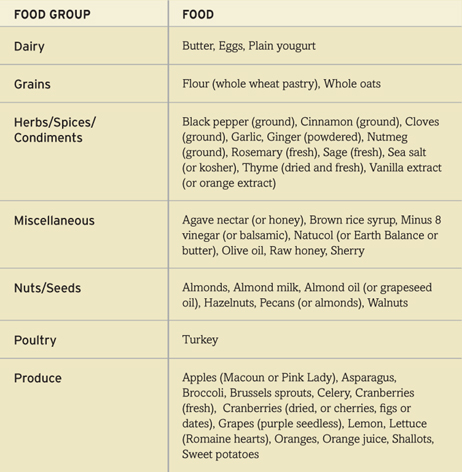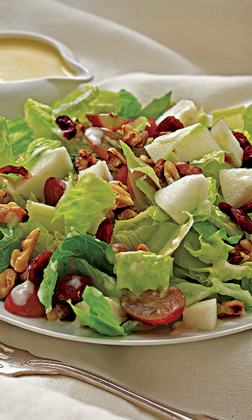

Holiday Waldorf Salad

Citrus-Stuffed Herbed Turkey
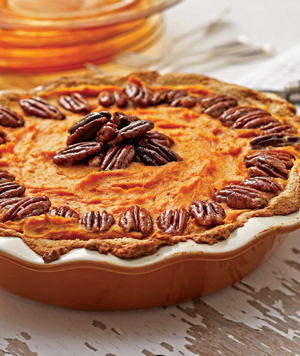
Sweet Potato Pie with Almond-Oat Crust
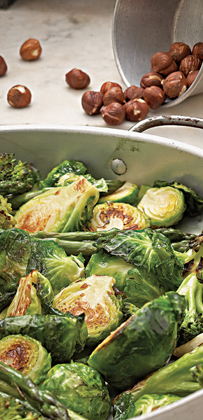
Roasted Brussels Sprouts, Asparagus, and Broccoli with Toasted Hazelnuts
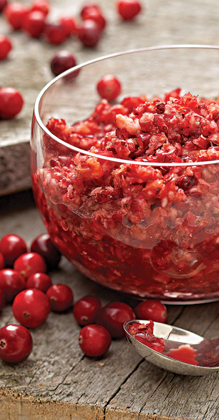
Cranberry-Orange Relish
224 Citrus-Stuffed Herbed Turkey
230 Roasted Brussels Sprouts, Asparagus, and Broccoli with Toasted Hazelnuts
237 Sweet Potato Pie with Almond-Oat Crust
WHEN I was the iVillage.com weight loss coach, each holiday season I received hundreds of questions on my message board about holiday eating. How to do it. How not to do it. Specifically, how to avoid the five to ten pounds that thousands of people gain between late autumn and early January and that few ever take off again. Is there a secret?
Well, no. Except to maybe try not to put the weight on in the first place.
Holiday time is a wonderful time of celebration, reunion, family, and—hopefully—gratitude. And unfortunately, overeating. It’s kind of built in to the season. But there are a lot of really smart things you can do to minimize the damage, both to your health and to your waistline. First and foremost: Eat meals like this holiday feast Jeannette put together, which provides an amazing cornucopia of nutrients and—for a holiday feast—an amazingly low amount of sugar. As for the rest of the things you can do, I’ve put together some of my favorite tips for holiday eating.
Meanwhile, let’s get to the food!
JUSTIFICATION TO EAT DESSERT FIRST
I can’t help myself; I have to start with the dessert.
If you’re going to eat dessert—and who isn’t around holiday season?—this is the way to go. You’ll love the Sweet Potato Pie with Almond-Oat Crust. Sweet potatoes are delicious in a variety of settings (including, by the way, as snacks, cold, right out of the fridge), and they are by far the most nutritious of all potatoes. Most orange foods contain a lot of either vitamin A or members of the carotenoid family or—as in the case of sweet potatoes—both. In this case, one medium potato has more than 21,000 IU of immune-supporting vitamin A and a nice hefty dose—more than 13,000 mcg—of beta-carotene. Plus there’s almost 4 g of fiber per potato, and more potassium than a banana. Not bad for the basis of a dessert!
To make the pie filling, you add to the sweet potatoes a couple of eggs, which are long one of my most favorite perfect foods for their combination of protein, good fat, eye-supporting carotenoids, and brain-supporting choline. Though Jeannette mentions one of the nonhydrogenated margarines as a possible shortening, I have no problem with butter, but I recommend you get it from organic or grass-fed sources, in which case butter can be a really fine food. (It made the cut in my book The 150 Healthiest Foods on Earth!)
The pie filling is naturally sweetened by a combination of orange juice and agave nectar. Agave nectar, which is also called agave syrup, is similar to honey but thinner, so it flows more easily. (There’s a dark kind and a light kind; the dark is less filtered, so a little richer in nutrients.)
The agave plant contains plant chemicals such as saponins and inulin. Saponins are natural detergents that are found in a lot of desert plants and may have some health benefits in humans. They bind to cholesterol and may help lower it. Other even more important benefits of saponins are being explored in research. In one Canadian study, saponins had an inhibitory effect on the growth of human carcinoma (cancer) cells in a test tube. And inulin is a type of fiber that actually serves as a probiotic, meaning it is food for the good bacteria in your gut.
Don’t misunderstand. You’re not going to get a ton of health benefits by using a little agave syrup as a sweetener, even though the actual agave plant does contain these beneficial compounds. And the syrup is hardly calorie-free. But the point is that as baking sweeteners go, this one has a pretty darn good pedigree, and it beats the heck out of the usual granulated sugar that’s used in recipes like this one.
Meal Prep Tips
• Holiday prep can be crazy-making. To enjoy your holiday meal, plan with some care.
• Make the Sweet Potato Pie with Almond-Oat Crust one day ahead or first thing the morning of your meal.
• Make the Cranberry-Orange Relish the morning of your meal.
• Begin the Citrus-Stuffed Herbed Turkey prep five to six hours before you want to be sitting down to eat.
• Prepare the Roasted Brussels Sprouts, Asparagus, and Broccoli with Toasted Hazelnuts one hour before the end of the turkey cook time and slip them into the oven when you remove the turkey to rest.
• Make the Waldorf Salad right after the veggies go in to roast.
Urban Legend: The Turkey Made Me Sleepy
Many people believe that the reason they get so sleepy after a big holiday meal containing turkey is that turkey contains tryptophan, which is an amino acid that the body uses to make serotonin, a brain chemical involved in promoting feelings of calm and relaxation.
It’s true that tryptophan does make you sleepy. In fact, it was at one time very popular as a sleeping aid. And it’s also true that turkey does contain tryptophan. But it’s a pretty small amount; no more than many other protein sources. Besides, for tryptophan to have that kind of an effect you’d have to take it alone on an empty stomach. And you’d have to take a lot more than is found in turkey.
So it’s an urban legend that the tryptophan in turkey makes you sleepy. What really makes you sleepy is overeating. Tons of calories, many of them from sugar, drive blood sugar up and then way back down again, making you feel like a zombie. Blood is diverted from the extremities (and the brain) to the digestive system to handle the load. No wonder you doze.
Falling asleep before the dishes get washed has absolutely nothing to do with tryptophan. Sorry. And by the way, how many beers did you have with that meal again?
There was some discussion among “Team Jonny” about the use of flour in this recipe (and some others), so here’s the deal: We decided that the amount used here is not going to kill you. All the other ingredients are terrific—we’re talking, after all, about making a pie, and there’s just not much you can do without at least a small amount of the stuff. Do I love the idea of flour in general? Of course not. But let’s get real. We’re making a holiday meal and it includes pie. All things considered, this is a great recipe, and while it might not be perfect, I think the amount of flour we needed to include to make it come out right is ultimately a pretty minor problem as far as your overall health goes. And guess what? You can avoid the whole issue by making it crustless; it tastes absolutely great that way! (See “Notes from the Kitchen” on page 237.)
THE NEW WALDORF SALAD
The Waldorf Salad was created by Oscar Tschirky, the maitre d’hotel (not the chef) at the famed Waldorf Astoria hotel in New York, in 1896. It was an instant hit back then, and this version—Holiday Waldorf Salad—will be an instant hit in your kitchen more than a century later.
If you’re new to the Waldorf Salad, you’ll be certain to remember this one. The classic Waldorf had apples, celery, raisins, walnuts, and mayo as key ingredients; later versions added all kinds of spices, yogurt, orange juice, grapes, pears, dates, and even Cajun seasoning. Jeannette’s version is classic, simple, delicious, and healthy. Based around apples and celery, it substitutes yogurt for the mayo, sweetens with a little honey and orange, and spices up with ginger, walnuts, cranberries, and grapes. You also have the option of adding cherries, figs, or dates. It’s loaded with phytochemicals from the fruit, plus fiber from the apples, and—if you use the walnuts—some omega-3 fats. And … it’s beyond delicious.
What traditional holiday meal is complete without cranberry sauce, here jazzed up in Cranberry-Orange Relish? The little berries possess anticancer properties, inhibit the growth of common pathogens and microbes, and are well known for having antibacterial properties that aid in the prevention of urinary tract infections.
Because of their high vitamin C content, cranberries have one of the most potent antioxidant résumés of any fruit, and they can act as a great preventive against atherosclerosis. They are best known for their usefulness in treating urinary tract infections because the acidity of cranberry makes the urine more acidic and kills the infection. Another way they work is by inhibiting the adhesion of bacteria to the mucosal wall of the gastrointestinal tract, thereby preventing the bacteria like H. pylori and E. coli from “sticking,” growing, and proliferating.
Cranberries even have bioactive compounds that have been found to be toxic to a variety of cancer tumor cells. It’s actually a shame that we don’t eat them on a regular basis and save them only for special holiday meals, when a lot of the stuff we normally eat is half cranberry, half sugar. But not the special Cranberry-Orange Relish featured in this meal. You’ll get all the health benefits of real cranberries, sweetened only with a little honey or agave nectar and flavored with orange. What could be better?
BROCCOLI AND BRUSSELS SPROUTS: VEGETABLE ROYALTY
Before getting to the main course (did you notice we’re kind of working backward here?), let’s talk for a minute about the vegetable side dish, Roasted Brussels Sprouts, Asparagus, and Broccoli with Toasted Hazelnuts. Earlier (see page 155), I talked about what I call the royal family of vegetables, the Brassica family. The head of this family (no pun intended) is cabbage, but every member of this family contains cancer-fighting indoles as well as other phytochemicals that are a boon to your health. And two of the stars of this royal vegetable dynasty are found in this wonderful side dish: broccoli and Brussels sprouts.
Broccoli and Brussels sprouts both contain a family of anticancer phytochemicals called isothiocyanates, which fight cancer by basically neutralizing carcinogens (cancer-promoting chemicals). Isothiocyanates have been shown to inhibit tumors and also to help prevent lung and esophageal cancer. Broccoli in particular contains a potent isothiocyanate that acts as an inhibitor of mammary tumors.
Broccoli also contains a compound called indole-3-carbinol, which is a strong antioxidant and stimulator of detoxifying enzymes that also acts as a traffic cop for estrogen, moving it along down the paths where it is least likely to be carcinogenic.
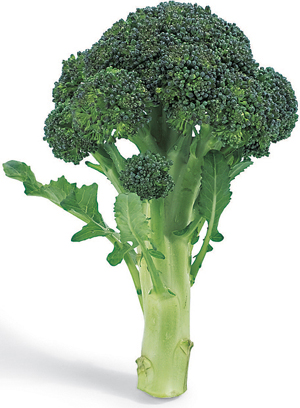
I’ve written elsewhere in this book (see page 179) and extensively in The 150 Healthiest Foods on Earth about why I believe organic, free-range meat is the best kind to buy, and all of that applies to turkey as well. You’re less likely to get a dose of antibiotics, steroids, and hormones with your meat when you buy birds that have been raised humanely and allowed to eat their natural diet. It’s that simple. If you’re going to eat meat, which is an individual choice, I hope you’ll buy the best you can possibly afford. The difference is worth it.
Brussels sprouts contain a chemical called sinigrin that suppresses the development of precancerous cells. When sinigrin breaks down, it creates a chemical called allyl isothiocyanate, which is the compound responsible for the characteristic smell of Brussels sprouts. But allyl isothiocyanate also persuades precancerous cells to commit suicide—a process called apoptosis.
And both Brussels sprouts and broccoli are high in a special superstar plant chemical called sulforaphane that helps increase the production of enzymes that “disarm” damaging free radicals and help fight carcinogens.
To this dynamic duo, Jeannette has thrown in some asparagus, which is a nice little low-calorie, high-potassium vegetable that is also is high in vitamin K, a lesser-known vitamin that’s essential for strong bones and healthy clotting. Add some heart-healthy olive oil, some immune system –strengthening garlic, and hazelnuts—which bring fiber, minerals, and healthy monounsaturated fat to the party—and you’ve got an absolutely smashing side dish that will make you feel virtuous just for looking at it, let alone eating it!
TERRIFIC TURKEY
Then there’s the main course--What else? Turkey, delicious in the Citrus-Stuffed Herbed Turkey. Turkey is a good source of protein, has some nice minerals such as potassium, and is fairly low in calories. Turkey is also low in fat, and most of the fat it does have is either monounsaturated or polyunsaturated. Even the dark meat has only a couple of grams of saturated fat per serving, which is nothing to worry about.
When you surround that succulent turkey with the outstanding Roasted Brussels Sprouts, Asparagus, and Broccoli with Toasted Hazelnuts, toss in the scrumptious Holiday Waldorf Salad, and garnish with the antioxidantrich Cranberry-Orange Relish, you’ve truly got a holiday feast. And you get to top the whole thing off with one of the best desserts on the planet—Sweet Potato Pie with Almond-Oat Crust.
Enjoy!
Here are some of our best suggestions for making holiday food even healthier!
1. Replace some butter with some olive oil, for a better balance of healthy fats. Try a 50/50 mix.
2. Replace heavy carbs such as potatoes and stuffing with herbs that can flavor up a turkey or vegetables.
3. Go organic to avoid hormones, pesticides, and antibiotic residues in meat or produce.
4. Replace mayonnaise with low-fat yogurt for tasty dressings without the extra fat and artificial stuff. (Note: There’s nothing wrong with mayonnaise, especially homemade from real eggs, but you’ll save some calories this way.)
5. Trim all visible fat from meats. Stick with lean cuts and white meat.
6. Consider more nutrient-dense foods for desserts such as sweet potatoes, pecans, and pumpkin. You’ll feel better about doing a little overindulging if the choices are healthier.
7. Check ingredients on any cans that you use. High-fructose corn syrup can reside in any package or can, and it is certain to be in canned cranberries. Avoid the bad sugars and look for fresher ingredients.
8. When choosing honey, try to find raw, unfiltered, cold-pressed organic honey. (See “Notes from the Kitchen” on page 233.)
9. Don’t overdo the number of courses. Stick with a few basics for a satisfying meal that doesn’t overstuff your guests.
10. Consider serving a salad as the last course (or dessert).
Wonderful as holidays may be for everything else, they can be downright deadly for sticking to a weight loss plan.
Because holiday eating can mean so many things—family stuff, office parties, special desserts, and the inevitable boxes of cookies at the water cooler—it’s hard to come up with one surefire strategy that will work for everyone in all situations. One strategy, however, will invariably make a difference no matter what the particulars of the situation: rehearsal.
Most of us know what we’re going up against. For some it’s the sight of the holiday table and relatives you haven’t seen all year. For others, it’s virtually everyone in the office bringing in their aunt’s special Christmas cookies. For still others it’s the stress eating associated with the mixed emotions of family reunions and juggling even more commitments than the usual overload. Even vacations can be stressful, and if they happen to involve airports at holiday time it’s a no-contest. Add it up and you’ve got a potential disaster. In fact, forget the “potential” part. You’re looking at emotional and physical overload, and what that means for your waistline (let alone your sense of well-being) is not good.
Rehearsing a problem situation in your mind before it happens helps you to arm yourself with strategies, visualize yourself doing them, and experience the positive results. That way you’re not caught unprepared, and you can actually practice reacting to a variety of dangerous situations.
That’s what coaches do with their athletes; it’s what boxing trainers do with their fighters. “When he throws that left hook, you step in under and throw a right to the body.” Studies have shown improvement in sports performance just through visualization exercises, in which, for example, basketball players mentally “practice” shooting baskets under various conditions. You can do the same thing with the holidays.
Of course, to do this effectively, you have to be clear on what you want to happen. That’s why I like using a tool I call the “proactive food journal.” Here’s how to do it: Pick a day, visualize what it’s going to be like, where you’re going to be, and with whom. Think about what food is likely to be available, when you’re likely to be hungry, and what the circumstances are going to be. (Is your Aunt Tina going to be there insisting you try her special key lime pie? Are you going to be in a restaurant known for its crème brûlée and homemade breads? Are you going to be in a fast-food restaurant taking care of six kids? Is the sister whom you hate going to be there silently judging everything you eat?
Now write down what you’re going to eat. Decide in advance, early in the day or even the night before. Visualize the situation. If there’s temptation or anxiety, close your eyes and picture it. Hear in your mind’s ear what people will say. See yourself responding in a way that would make you proud of yourself. That might be allowing yourself one or two bites of something “off your diet,” or it might mean being spartan. The point here is not what you choose, but that you choose it.
And that you then stick to it.
As Sondheim wrote, “The choice may have been mistaken. The choosing was not.” The point here is to put you in charge of what happens, not the circumstances.
If you can accomplish that, you have begun a journey that will help you manage your weight, and one that will empower you in all areas of your life.
Here are seven tips on how to use visualization to help you with holiday eating.
1. Close your eyes and really picture the situation clearly.
2. Ask yourself whether what’s being offered is going to be something that supports you in what you’re doing or takes you off course.
3. Decide what you wish to allow yourself to indulge in—if anything—and when you decide to do it, indulge in it with gusto.
4. Make the choice and take the action.
5. Don’t arrive hungry. A cup of soup or vegetable juice before arriving at a big event will help keep you in charge of your own actions.
6. Remember that stress leads to stress eating. Stress management is a critical part of managing weight gain during the holiday season.
7. If you do indulge, for goodness’ sake enjoy it!
Safety First
The Food Safety and Inspection Service recently changed the recommendations for how high a temperature cooked poultry should be cooked to. Previously, experts recommended cooking whole turkeys to 180°F (82°C) and turkey breasts to 170°F (77°C). The new cooking recommendation is 165°F (74°C) for both. Check the internal temperature in the innermost part of the thigh and wing and the thickest part of the breast with a meat thermometer.
A bounty of protein and potassium
Prep Time: Overnight to brine, overnight again for optional drying, and 30 minutes to prepare for cooking.
Cook Time: 3 hours and 45 minutes to 4 hours and 15 minutes, plus 20 minutes to rest before carving
Ingredients
Brining Solution
You will need 2 to 3 gallons (8 to 12 L) of brining solution for an 18- to 20-pound (8- to 9-kg) turkey.
Per gallon (4 L) of water:
1 cup (300 g) sea salt or kosher (not table salt)
½ cup (170 g) raw honey
2 teaspoons (4 g) finely grated lemon peel, optional
2 teaspoons (4 g) orange peel, optional
½ tablespoon cardamom pods, optional
1 teaspoon dried thyme, optional
Turkey
1 18- to 20-pound (8- to 9-kg) free-range, not self-basting, turkey
8 sprigs each of fresh rosemary (young and tender, not woody), sage, and thyme (or other herbs of your choice), rinsed and lightly dried (should total 1¼ to 1½ cups or 55 to 90 g when coarsely chopped)
2 shallots, peeled and halved
1 whole head garlic, peeled and crushed
1 lemon
1 orange
4 tablespoons (½ stick, or 55 g) butter, softened
2 tablespoons (28 ml) extra virgin olive oil
Salt
Ground black pepper
½ cup (120 ml) sherry
Starting with 2 gallons (8 L) of water, mix the brining solution in your roasting pan by combining all ingredients in correct proportions and stirring until the salt and honey are dissolved.
Rinse the turkey in plain water and pat it dry. Place the turkey in a lobster pot or large stockpot. (You can also use a plastic bucket if you line it with 2 or 3 clean garbage bags.) Pour in the brining solution to cover the turkey. If you need more brine to completely immerse the turkey, mix up another gallon. Place the turkey in the refrigerator for 12 to 24 hours. Remove the turkey from the brine, rinse very well under running water to remove all the brine, and dry thoroughly, including the cavity. (See “Notes from the Kitchen” on page 228.)
Preheat the oven to 400°F (200°C, gas mark 6).
Stem and coarsely chop the herbs, setting aside about three-quarters of them (⅔ to 1 cup or 40 to 60 g of herbs). Mince the remaining one-quarter (about ½ cup or 30 g) and put into a medium bowl. Add the shallots and garlic.
Quarter but do not peel the lemon and orange and squeeze them gently to make a little juice, tossing the fruit and juice together with the herb mixture.
In a small bowl, using your hands, mix the butter with the oil until creamy. Moving carefully so as not to puncture the skin, work your hand between the turkey skin and the breast as far as you can go to create a pocket over both breasts. Smear half of the butter-oil mixture over the breasts, covering as much meat as you can reach. Place half of the reserved, coarsely chopped herbs (or whole sprigs, see “Notes From the Kitchen” on page 228) in each pocket (on top of each breast). Do this carefully and when complete, gently reshape (from the outside) the herb “pouches” above each breast to look rounded and smooth. Salt and pepper the inside of both cavities and stuff them with the fruit and herb mixture. Tuck the wings behind the back, tuck the skin folds over the cavities to close, and truss the legs. Smear the entire bird with the remaining butter-olive oil mixture and sprinkle with salt and pepper. Slowly pour the sherry inside of the breast pockets, working it around to the leg joints.
Place a V rack inside of a roasting pan and cover it with foil. Poke about 15 holes into the foil. Place the turkey on the V rack, breast side down. Bake for 45 minutes, then reduce the oven temperature to 325°F (170°C, gas mark 3). Turn the turkey bird breast side up, baste (you can supplement the juices with a few tablespoons of sherry if you wish), cover with foil, and continue to cook for 2½ to 3 hours more, depending on the size of the turkey.
Remove the foil to brown the breast and continue to cook for another 30 to 40 minutes, or until the thickest part of the breast and innermost parts of thighs and wings register 165°F (74°C) on a meat thermometer. (When the turkey is done, the legs should roll loosely on the joint, and the leg juices should run clear.)
Let the turkey rest on a cutting board for about 20 minutes before carving.
Yield: For turkeys weighing more than 12 pounds, allow ½ to ¾ pound (225 to 340 g) per person, so an 18-pound (8-kg) turkey can serve between 24 to 36 people (photo page 226)
• People tend to go overboard with amounts and number of dishes in a holiday meal. There’s really no need for this. Try serving just the four basic courses in this simple, elegant, and nutritious meal. No one will complain.
• Finding a free-range turkey for Thanksgiving may not be as easy as you might think. “Free-range” simply means that the birds have access to the outside, but many don’t make it out to graze and roam because of the crowded conditions and other inhumane practices used to guarantee quick-growing, profitable turkeys in time for the holidays. So it’s worth the effort to shop around. We recommend two websites for more information: www.localharvest.org and www.slowfoodusa.org. Both can point you in the direction of local farmers who live by a philosophy of clean, delicious organic turkeys that are raised in humane conditions.
• Brining, a very simple process, improves the quality of the cooked turkey. The combination of the salt and sugar helps the cells of the meat to both open and retain moisture, creating a juicier end product. You can experiment with adding different herbs and spices to the mixture, such as cinnamon sticks, whole peppercorns, or try a fresh bunch of thyme instead of the dried. Also, some people like to use apple cider in place of half of the water.
• If you brine the turkey right before cooking, the skin will not become as crisp because it will “steam” during cook time. If you want a crisper skin, brine the day before, rinse the turkey as directed, and place it uncovered, breast side up, in the basting pan overnight in the refrigerator. This allows the excess moisture to evaporate, and you will get a crispier skin when it’s cooked.
• Most fresh organic turkeys do not come self-basted. If you manage to find one, it’s probably brined in table salt, complete with iodine load, which is not great for the meat, and white sugar. This is not terrible, it’s just much poorer quality.
• If you are working with a large bird (that will take a longer cooking time) or desire a milder herb flavoring, use the whole sprigs (without chopping) under the skin. Just remove the large pieces when the cooking is complete and use them as a garnish.
• If you don’t own a V rack, try using 2 miniature loaf pans (4 or 5 inch × 3 inch, 10 or 13 × 8 cm) face down and set on either side of your roasting pan (in the middle, lengthwise). If using the loaf pans, no need for tinfoil over the “rack.”
• This type of whole-bird preparation typically calls for a stick or more of butter. Consider using half butter and half extra virgin olive oil, as we have done here, which introduces some mono-unsaturated fat.
• Here’s how to carve a turkey:
1. Place the turkey on a cutting board with a trough to catch the juices. Cut through the crispy skin that connects the leg and the breast and slice down, pulling the thigh away from the bird. Continue until you reach the joint and cut through it to separate the leg.
2. Carve off the breast meat in one piece: Slide the knife along one side of the breastbone, as close to the bone as possible. Cut the breast off the carcass.
3. Place the breast meat on the cutting board and thinly slice. Transfer the meat to a platter.
4. Place the leg on the board and cut through the joint between the thigh and drumstick. Transfer to the platter. Detach the wing where it connects to the bird. Transfer it to the platter, then repeat.
• By avoiding the typical stuffing, mashed potatoes, and gravy fillers in this healthier turkey dinner, you are eliminating a significant portion of the fat, not to mention reducing the number of calories from simple carbohydrates that often load up holiday meals. The herbed meat of this turkey is so flavorful that you won’t miss a thing!
• Don’t throw the turkey carcass away! Once you’ve eaten most of the meat, save the skeleton and remaining meat bits to make a turkey broth for fabulous soup. If you’ve had it with turkey for the moment, freeze it for a couple of weeks and make turkey soup as a warming winter treat.
A healthy harvest of cancer prevention
Prep Time: 20 minutes
Cook Time: About 25 minutes
Ingredients
1 pound (455 g) Brussels sprouts
1 or 2 whole peeled cloves garlic, halved if they are large
2 teaspoons (10 ml) plus 1 tablespoon (15 ml) extra virgin olive oil
Salt
Ground black pepper
1 pound (455 g) thin asparagus spears
2 to 3 large crowns broccoli
¼ cup (60 ml) Minus 8 (or balsamic) vinegar
¼ cup (35 g) hazelnuts, lightly roasted and coarsely chopped
Preheat the oven to 375°F (190°C, gas mark 5).
Stem the Brussels sprouts and cut them in half, quartering any large ones. Place them into a medium bowl. Add the garlic and 2 teaspoons (10 ml) of the oil and season lightly with the salt and pepper.
Spread the Brussels sprouts in a single layer in a small baking span and roast for 10 minutes.
Meanwhile, trim the asparagus. Remove the tough lower stems from the broccoli, peel off the tougher stem skin with a paring knife, and slice the stalks lengthwise into long strips from stem through florets. Toss the asparagus and broccoli gently in a bowl with the remaining 1 tablespoon (15 ml) of the oil and light salt and pepper until coated.
Spread the asparagus and broccoli on a second baking sheet, sized to fit in the oven with the first.
After the Brussels sprouts have roasted 10 minutes, add the broccoli-asparagus pan to the oven, and continue to roast for about 15 minutes longer until all vegetables have softened, turned bright green, and lightly browned.
Meanwhile, warm the vinegar in a small saucepan and simmer lightly until it begins to reduce and thicken slightly.
When vegetables are complete, remove the garlic and blend it with the warm vinegar in a blender.
Arrange the vegetables on 2 serving platters, with the broccoli framing the plate of Brussels sprouts and plate of asparagus. Spoon the vinegar evenly over the vegetables, sprinkle with the nuts, and serve at once.
Yield: 6 to 8 servings
• Always roast or toast nuts and seeds at relatively low temperatures because their oils are delicate. On the stovetop: Dry-sauté nuts in a pan on medium-low. In the oven: Spread a single layer of nuts on a baking sheet and roast in a warm oven (350°F, 180°C, gas mark 4) for just a few minutes for seeds and 7 to 12 minutes for nuts. Only heat seeds until they release their oil; you can smell the change. Seeds are the most delicate; don’t let them actually brown or they will turn slightly bitter. Nuts can turn a warm golden brown, but they scorch easily, so watch them closely toward the end of the cook time. Look closely at your nuts and seeds. Can you see a faint sheen developing and smell their rich aroma? Then they are almost done!
• To get the right consistency of the hazelnuts in this recipe, pound them in a paper bag with a meat mallet on your cutting board.
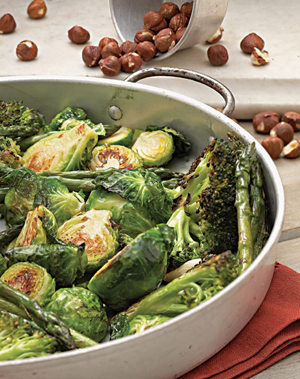
A healthy, fiber-filled version of this classic dish
Prep Time: 5 to 10 minutes
Cook Time: None
Ingredients
¼ cup (60 g) plain low-fat or full-fat yogurt
1 teaspoon raw honey
3 tablespoons (45 ml) freshly squeezed orange juice
¼ teaspoon powdered ginger
2 small crisp red apples (such as Macoun or Pink Lady), cored and chopped into small pieces (about 2 cups or 300 g)
4 celery stalks, thinly sliced
½ cup (75 g) purple seedless grapes, halved, optional
¼ cup (37 g) dried cranberries or cherries or chopped figs or dates
½ cup (75 g) lightly toasted walnuts, coarsely chopped
8 cups (160 g) hearts of romaine, chopped into bite-size pieces
In a small bowl, whisk together the yogurt, honey, orange juice, and ginger.
In a salad bowl, combine the apples, celery, grapes (if using), cranberries or cherries, walnuts, and romaine.
Pour the yogurt dressing over the salad and toss all together to combine well.
Yield: 8 servings
• The Waldorf Salad makes a terrific dessert. Or by adding some chicken, you can make it into a main dish. It’s especially great for summer lunches, and it travels pretty well in an airtight container.
• Replacing the mayonnaise with low-fat yogurt transforms this timeless dish into a healthy classic.
• Using yogurt instead of oil as a base allows you to create a myriad of tasty low-fat dressing options. Try a savory dressing with fresh minced garlic, chopped chives, lemon, and pepper.
• When choosing honey, try to find raw, unfiltered, cold-pressed organic honey. It’s a whole different food from the stuff in the squeezy bear. Since the honey hasn’t been processed at high heat, it still contains live enzymes. It also contains plant polyphenols that are known for their antioxidant activity and are important for human health. P.S.: Raw unfiltered honey tastes better, and it’s just as sweet as the commercial stuff. Neither raw nor commercial honey spoils.
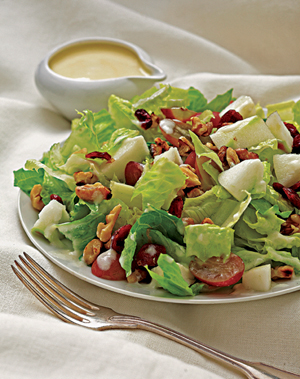
Autumnal antioxidants
Prep Time: Less than 5 minutes
Cook Time: None, but the flavors will develop if left to sit for a couple of hours before serving
Ingredients
4 cups (440 g) fresh cranberries, or two 8-ounce (225-g) bags frozen unsweetened, thawed and rinsed
2 oranges, peeled and halved
⅔ cup (230 g) agave nectar or honey, or more or less to taste
In a blender or food processor, blend together the cranberries, oranges, and agave or honey until a juicy relish is formed.
Yield: 12 to 14 servings
• Put this relish in heavy rotation on your menu of choices for meals throughout the year, not just at holiday season. Feel free to halve the recipe if you need less at one time. The relish goes well with a surprisingly wide variety of dishes, and cranberries are really, really good for you!
• If you can’t find fresh cranberries, you can substitute 4 cups (440 g) dried whole cranberries, but use 4 small oranges and omit the agave/honey. Dried cranberries are almost always heavily sweetened, so this version doesn’t have the crisp tartness of the fresh, but it is still better for you than the stuff in a can! Look for juice-sweetened dried cranberries only, not the sugar-sweetened varieties.
• Cranberries are delicious and nutritious, and they’re also beautiful. If you wish to serve a canapé or cheese platter during a holiday gathering, fill your serving platter with a bag of fresh cranberries and place the food items on the top—lovely!

Rich in vitamin A and beta-carotene
Prep Time: 20 to 25 minutes
Cook Time: About 50 minutes
Ingredients
Pie Filling
3 pounds (1¼ kg) sweet potatoes (5 or 6 medium), peeled and cut into 1½-inch (4-cm) pieces
2 eggs
¼ cup (85 g) agave nectar
¼ cup (60 ml) almond milk
¼ cup (55 g) melted Natucol or Earth Balance (nonhydrogenated vegetable spread) or butter
3 tablespoons (45 ml) freshly squeezed orange juice (from about ½ orange)
1 teaspoon vanilla extract or ½ teaspoon vanilla extract and ½ teaspoon orange extract
1 teaspoon ground cinnamon
½ teaspoon ground nutmeg
¼ teaspoon ground cloves
Pie Crust
⅔ cup (54 g) whole oats, ground into flour in food processor
⅔ cup (100 g) almonds, ground into fine meal in food processor
⅔ cup (74 g) whole wheat pastry flour
¼ cup (60 ml) almond oil or grapeseed oil
¼ cup (85 g) agave nectar
¼ cup (60 ml) water
Pie Topping
1 cup (100 g) raw pecan halves or toasted sliced almonds
2 tablespoons (40 g) brown rice syrup
1 tablespoon (20 g) agave nectar
• This dish works perfectly well crustless. To avoid flour entirely or speed up the preparation time, omit the crust and bake the sweet potato filling in an 8-inch (20-cm) square glass baking dish and serve it “naked.”
• Having your heavier starchy vegetables for dessert is both filling after lighter holiday fare and significantly higher in nutrients than typical fruit pies, with less than a third of the fat.
• You can replace the cinnamon, nutmeg, and cloves with 2 teaspoons of pumpkin pie spice.
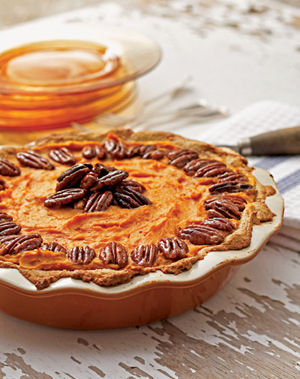
To make the pie filling: Preheat the oven to 350°F (180°C, gas mark 4).
Place the sweet potatoes in a large pot of boiling water and boil until very soft, for 10 to 12 minutes.
Meanwhile, place the eggs in a mixer and beat well.
When the potatoes are soft, drain them well and add them to the mixing bowl.
Add the agave nectar, almond milk, spread or butter, orange juice, extract(s), cinnamon, nutmeg, and cloves and mix until light and fluffy with no lumps.
To make the pie crust: Place the oats, almonds, and flour in a large mixing bowl and mix to combine.
In a small bowl, whisk together the oil, ¼ cup (85 g) agave, and water. Pour them into the oat mixture. Mix until well combined. (The batter will be sticky.)
Oil a 10-inch (25-cm) deep-dish pie plate and spread the crust mixture evenly onto plate with oiled fingers.
To make the pie topping: Place the pecans in a single layer on a baking sheet and place nuts and pie crust into preheated oven. Bake for 5 minutes and start checking the pecans, being careful not to scorch them. Remove after 5 to 8 minutes, or when lightly toasted. Remove the crust after 10 minutes.
In a small bowl, combine the brown rice syrup and 1 tablespoon (20 g) agave nectar and add the hot pecans, tossing to thoroughly coat.
Spoon the potato mixture gently into the crust and arrange the nuts on top of the filling. Bake for 30 to 35 minutes, or until the crust is lightly brown at the edges. Cool the pie for at least 20 minutes before serving.
Yield: 8 servings
Fifty percent of all charitable giving is done during the holidays at the end of the year. It’s a great time to remember how fortunate we are and to reach out to those who are less so. For those so inclined, here are a few ways you can make a difference this holiday season (or any other time).
Consider setting up a giving tree in your place of business. You simply contact local social service organizations, tell them you’d like to set up a giving tree, and expect them to interview kids to find out what they would most like to receive this season. Buy a live or artificial tree and place it in a well-trafficked area. Collect cards or “ornaments” that the agency will prepare containing a child’s name, age and gift request, and hang those on the tree (for example: Kim, age 6, Barbie doll). Suggest that donors find a wish they’d like to make come true, purchase the gift requested, wrap it, and put it under the tree. (Make sure the request card is attached so the right gift goes to the right child.) Then just arrange for the agency to deliver the gifts to the kids, and know that you’ve made some less fortunate kids very, very happy.
Other charities to consider: Toys for Tots (www.toysfortots.org), Make-A-Wish Foundation (www.worldwish.org), and one of my personal favorites, Mercy Corps (www.mercycorps.org).
Local charities deliver holiday dinners to needy people in almost every city. (The New York City Rescue Mission in New York City is one, but you can easily find its counterpart in the city or country in which you live.)
What’s most important is not who you give to, but that you do it.
Oftentimes you aren’t in the mood for something sweet, but you’re hungry and you need a pick-me-up between meals. This is the perfect time for a savory snack.
Savory snacks (and mini-meals) provide another golden opportunity to add a variety of different nutrients to your daily diet. Didn’t load up on the vegetables at lunch? Now’s your chance—grab a handful of rainbow-colored crudités and some zippy lemon hummus for dipping.
Or perhaps you had a light veggie-based lunch like a big spring salad, but you didn’t have enough protein with it and an hour later you’re hungry again: Pull out a tuna pack and enjoy it straight with a squeeze of lemon or a tablespoon of fruit-sweetened cranberry sauce (Knudsen makes one).
Nuts are a key part of the polymeal formula but they don’t go easily into every meal menu. Snack time provides the perfect chance to grab a small handful. They are so rich in fiber and great fats (even a little protein) that they make an ideal stand-alone savory snack. Jeannette carries raw almonds with her everywhere she goes—they fit right into her purse!
Try these other savory snack ideas:
• Veggie sticks paired with any protein
• A part-skim mozzarella stick with carrots or celery
• Baby carrots poked into green or black olives
• Rice cakes with hummus or nut butter
• Whole wheat or rice pretzels or crackers with any nut or protein spread, meat, fish, or cheese
• Smoked fish with horseradish on whole wheat or rice crackers
• Cottage cheese with tomatoes or peppers and sea salt/pepper
• No-sugar bean dip or refried beans with baked tortilla chips or raw veggie sticks
• Salsa and avocado with baked corn chips
• Babaghanoush with veggie sticks
• Shrimp with low-sugar cocktail sauce
• Boiled egg alone or with veggies
• Non-nitrate cold cut roll-ups around veggie sticks
